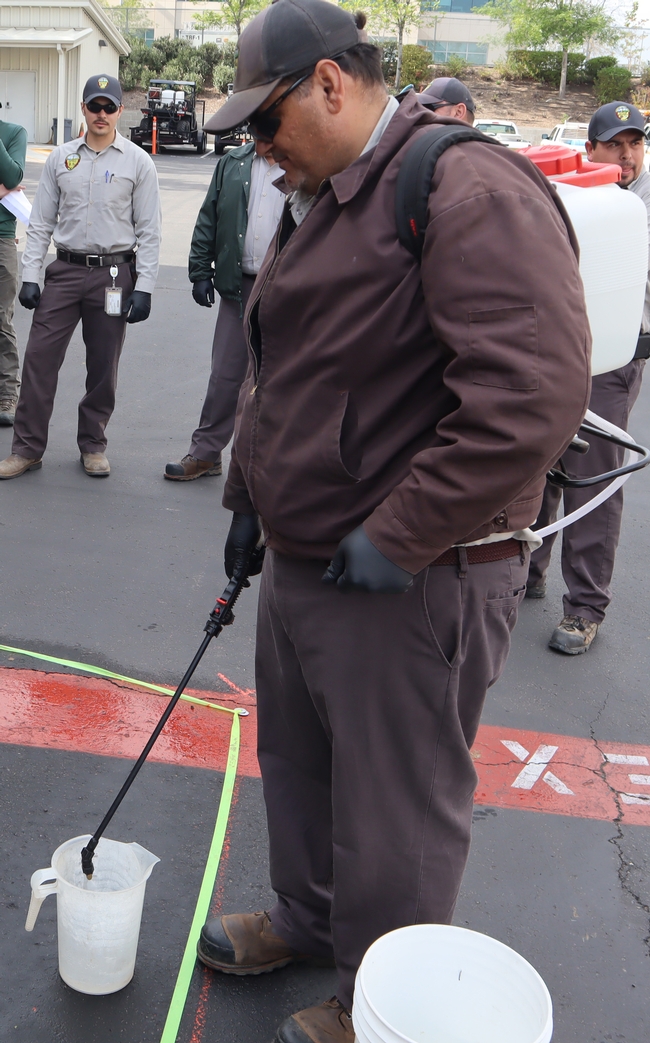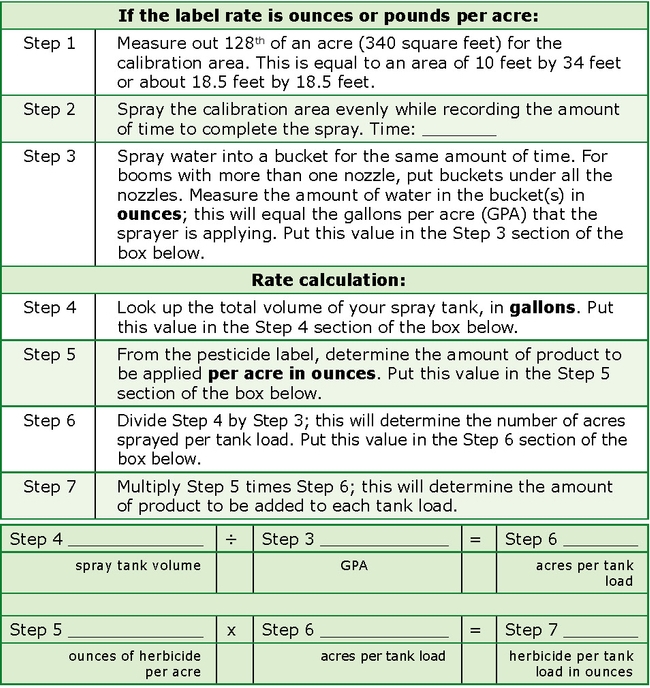Applying the wrong amount of pesticide can result in poor control if not enough is used; too much being applied can lead to waste and possibly illegal usage. If pest control is insufficient, the end result might be a second application that will be more expensive due to the cost of labor involved. If the pesticide is overused, the cost of the extra material is one consideration, but there might also be plant damage and a higher risk of pesticide moving off-site in runoff or leaching into groundwater.
In addition to reading the label carefully and making sure that pesticides are not washed off into storm drains, the applicator must be sure equipment is properly calibrated so that the proper amount of pesticide is applied. Poor calibration also can result in a lot of leftover pesticide in the sprayer. The less that is leftover, the less there is that must be disposed.

For liquid applications, one needs to know the area to be sprayed, how much pesticide product is needed to treat the area, and how much water to use so the solution will cover the treatment area. Because people walk at different speeds or otherwise may operate spray equipment differently, it is important that each individual applicator perform calibration steps, especially if the equipment is shared. Similarly, individual pieces of equipment may vary in performance, so it's important to calibrate each piece of equipment with the applicator, even if you have several of the same make and model.
Liquid applications are usually made using backpack sprayers (Figure 1) or hand cans with single nozzles and hand-operated pumps, vehicle-mounted tanks with gun-type nozzles and electric or gas pumps, or agricultural equipment with tank and boom supporting multiple nozzles.
Here we provide several methods you can use to calibrate equipment for specific broadcast spray situations. Follow the steps below to calibrate small sprayers for small treatment areas. Another method that can be used for larger sprayers and larger treatment areas is illustrated in Table 1. For estimating how much pesticide may be needed when spraying trees and shrubs, see the Ask the Expert! section on page 6 of the Green Bulletin.

Backpack & Hand Can Sprayers
- Measure out a representative area of 1,000 square feet (20 by 50 feet works well, or 5 by 200 feet is good if you are going to be spraying medians).
- Put clean water into the tank without any pesticide product.
- Walking at your normal pace and using your normal method of spraying, record the time it takes for you to spray the area you measured. It is best to do this two or three times to calculate an average time.
- Get a bucket or other container that has markings in ounces and spray water into it for the same amount of time required for you to spray 1,000 square feet. This amount is how much water you need to put in the tank for 1,000 square feet.
- Where will you be spraying? Measure the area to be treated. If you plan to make several small applications to a number of locations, you can combine the measured areas.
- How much pesticide product do you need? Many pesticide labels provide application rates as ounces per 1,000 square feet. If you have 2,000 square feet and the label says 5 ounces per 1,000 square feet, then you need 10 ounces of the pesticide product. If you have 500 square feet and the label says 5 ounces per 1,000 square feet, then you need 2.5 ounces.
- How much water do you need? In a previous step (above), you determined how much water is needed for you to cover 1,000 square feet. If you need to spray 2,000 square feet, you will need two times more water (2,000 divided by 1,000 equals 2); if you need to spray 500 square feet, you would need half as much water (500 divided by 1,000 equals 0.5).
Want to make your backpack sprayer calibration more accurate? Use the retrofit in Table 2 on page 7 of the Green Bulletin (provided by Danny Hirchag, Urban Forest Superintendent at UC Irvine) to improve calibration and ensure you are evenly applying the correct amount of pesticide product.
Let's Try an Example
- Output: You find it takes 130 seconds for you to treat 1,000 square feet with a specific sprayer. When you spray water with this sprayer into a bucket for that same amount of time, you find that you applied 22 ounces.
- Area: You need to treat three locations; one is 600 square feet, one is 900 square feet, and the third is 200 square feet. So you will be spraying a total of 1,700 square feet (600 plus 900 plus 200).
- Pesticide: The pesticide product label calls for a rate of 2 ounces per 1,000 square feet. Since you need to treat 1,700 square feet, you will need 1.7 times more pesticide (1,700 square feet divided by 1,000 square feet = 1.7). Multiply 1.7 by 2 ounces, and the result is 3.4 ounces.
- Consider pesticide product formulations: In this example, treatment of 1,000 square feet used 22 ounces of water but you are going to spray 1,700 square feet. Take 1,700 and divide it by 1,000, and the result is 1.7, so you need to add 1.7 times more water. For 1,700 square feet, we multiply 1.7 by 22 ounces of water, resulting in 37 ounces of water needed.
- If the pesticide product is a liquid formulation, then you will need to subtract the amount of liquid pesticide product added from the total amount of water needed. Therefore, to get 37 ounces of solution, you will need to subtract the 3.4 ounces of pesticide product added to determine the amount of water you must add (37 ounces total solution minus 3.4 ounces of pesticide equals 33.6 ounces of water).
- If the product is a dry formulation like a wettable powder, you will mix 37 ounces water and 3.4 ounces of dry pesticide product.
- In both cases, you would use the final solution to spray 1,700 square feet.
[Originally published in the Winter 2019 issue of the Green Bulletin, a newsletter that focuses on specific practices and information that landscape and structural pest management professionals. Subscribe to receive the newsletter electronically.]